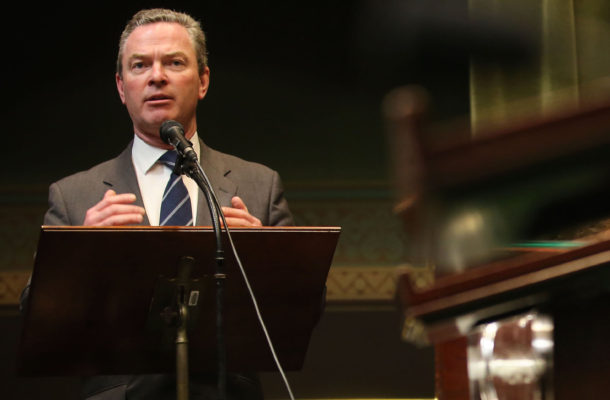Australian Defence Industry – Our National Endeavour
Christopher Pyne MP | September 12, 2017

The Hon. Christopher Pyne MP spoke about the crucial role entrepreneurial midsize businesses will play to our future wellbeing; to defence and the economy at the GAP Summit on 8 September 2017.
It’s a pleasure to return to the Global Access Partners Annual Economic Summit to speak with you today.
We share some similar concerns. We both recognise that defence and national security are vital to our economic prosperity – that we cannot have one without the other. And we both recognise that entrepreneurial midsize businesses will be crucial to our future wellbeing; to defence and the economy.
North Korea’s nuclear provocations have taken us into dangerous new territory. We face a challenging strategic environment. Australians can no longer consider themselves far removed from strife. Instead we are confronted more than ever by two blunt realities.
We sit in the heavily militarised Indo-Pacific region – a region which we share with seven of the world’s 10 largest standing militaries and five of the world’s declared nuclear nations. And our economic prosperity fundamentally relies on free and uninterrupted passage in our region over the ocean through strategic sea-lanes. The Turnbull government is remaking our defence forces to equip us for the challenges this environment creates; to guarantee we can protect our borders, our interests and a global rules-based order.
We are also transforming industry, building a new sovereign defence sector and leveraging off that to create the culture of innovation and the smart manufacturing industries vital for economic success in the twenty-first century. Strong, smart and resilient small to medium enterprises are crucial partners in this task.
They are vital to the preparedness of our current military forces and their ability to conduct operations; the development of future military capabilities and the ability of our nation to quickly mobilise industrial resources during times of crisis and conflict. The discussions and conclusions of this forum will have their own important role to play, enhancing and informing this agenda.
Today, I want to focus on the government’s visions for Australia’s defence industry and the important role midsize businesses have in contributing to defence capability.
The Government is embarking on an unprecedented $200 billion investment in the renewal and modernisation of our defence capability over the next decade. I want to focus for a moment on that word “investment”. Too often in politics “investment” is simply a fancy substitute for “spending”. Today, I’m not talking about some cash splash. I am talking about an investment.
The government’s investment in defence is a considered and carefully calculated allocation of funds designed to provide the maximum return to the nation. It is designed to equip the Australia Defence Forces with the tools they need – but it is also designed to spur on innovation in Australian industry and give Australian workers rewarding, skilled careers.
This investment comes with a twin commitment: a commitment to provide the best possible capability we can afford for the men and women of the Australian Defence Force and a commitment to ensure Australian industry can develop and sustain the highest levels of technology, advanced manufacturing and innovation and support our defence activities. Yes, we will continue to acquire many of our major platforms and systems from the United States and our international allies.
We welcome multinational primes establishing and expanding their footprint in Australia. We welcome them because the expertise and investment that they bring will be crucial to delivering our ambitious capability renewal program. It won’t only create opportunities for Australian small to medium enterprises to be involved in the acquisition, integration and sustainment of our capabilities. It will give them access to international best-practice, to new technologies, new manufacturing methodologies and quality build systems – access they can apply to building and sustaining Australian industry capability.
Our investment in defence capability is making Australia an attractive place to do business. At the same time, however, we’re expecting more from our international partners and contractors. The 2016 Defence Industry Policy Statement is driving an agenda to maximise opportunities for the involvement of Australian industry in meeting the capability needs of the ADF. We are growing our sovereign industrial base to meet our defence needs and to maximise expenditure of Australian taxpayer dollars here in Australia.
We have placed stronger requirements on tenderers for our major capital projects – those worth $20 million and above – to look for more opportunities to involve Australian industry and to build enduring industrial capability that can be used to meet broader defence needs. We have also sought clear strategies for technology transfer, innovation and opportunities for Australian small to medium enterprises to be part of international supply chains. We are changing the way we do business and foster innovation, transforming our defence industrial base so it is better equipped to deliver and sustain our defence capabilities over the coming decades and becomes a key driver of the boarder national economy.
The stronger, more innovative and quicker off the mark our defence industry is, the better equipped the ADF will be. We already have companies like Thales Australia and Austal who are able to hold their own in the global marketplace. I want to see more of our defence companies join their ranks.
Last year the Defence Industry Policy Statement calculated that our defence industries consisted of over 3,000 SMEs, employing over 25,000 people. We know those numbers have grown since then as we see defence industry invest in research and development to meet new opportunities. Some of these companies have already developed and commercialised their own technologies and are exporting their capabilities, subcontracting other SMEs, knocking on the doors of the Primes.
There are companies like Ferra Engineering in Brisbane, which moved from the automotive to the aerospace sector in 2002. Since then it has become a trusted supplier to some of the world’s largest players; the likes of Boeing, Lockheed Martin and Northrop Grumman. Ferra’s accomplishment hasn’t only seen them establish a global footprint into markets of the size and significance of the United States, India and, most recently, the United Kingdom. It has seen them grow a local supply chain that now involves some 30 other Australian companies.
Indeed, their overseas expansion has resulted in increased activity in Australia, with 87 per cent of their products produced here going into world-class platforms like the F-35 Joint Strike Fighter, the Triton Unmanned Aerial System and MH60 Romeo helicopter. This is exactly the type of midsize business success story we are working to replicate through our vision for the Australian defence industry. Ferra have recognised that we are following through on our commitment to help the local defence industry grow and promote it to the world.
We believe midsize businesses will be key to our vision for a new Australian defence sector and are doing everything we can to enable their success. There’s no more basic sign of that than the existence of my portfolio. We have given defence industry a voice at the cabinet table for the very first time. There could be no clearer demonstration of the importance the government gives to the sector.
The government’s vision for defence industry is straightforward too. We want a sovereign, world-leading, innovative sector; one that can deliver the very best capability to the ADF on time and on budget. But we also want an industry capable of going those few steps forward, in stride with global pacesetters.
We want to see a defence industry that excels at exporting; an industry that builds on our relationship with allies and partners and furthers our strategic interests. Across the nation industry is making the transition to high-tech manufacturing, embracing the innovation that will drive our continued national prosperity. We want defence to be a leader of this trend, an exemplar – again, a pacesetter. Our defence sector is developing some truly remarkable technologies.
I want ordinary Australians to realise just how cutting-edge the work in this country on defence technologies is. I want them to know how defence firms are taking the stuff of science fiction and exploring how it could be used to transform their lives – creating skilled and well-paid work along the way. That is why I keep talking about the Turnbull Government’s unprecedented defence expenditure program as our great national enterprise.
A transformation is underway, a transformation with long reaching benefits not just for the ADF, not just for defence industry, but for the entire country. I want as many Australians as possible to be part of what we’re doing; to understand the ambition of the task, to have that sense of pride that comes from shared ownership and participation.
I also want them to understand the methodological way in which the government is working this through; planning for the future and creating the policy setting that will allow the Australian defence industry to thrive and deliver. I want them to understand why we are so firmly focussing on what we can achieve today, what we want to achieve tomorrow and the steps between the two.
We’ve dealt with the very fundamentals: strengthened the Australian Industry Capability Program, established the Centre for Defence Industry Capability and fine-tuned our suite of defence industry skilling and export programs as a prelude to their expansion. This means we’re already able to leverage the current strength of Australian industry to deliver on immediate commitments and priorities while positioning the sector for the future.
The Centre for Defence Industry Capability, for example, is providing a new way of letting our SMEs realise the opportunities available to them, a clear front door for the sector to essential advice and services to support growth and facilitate innovation – already, I might add, experiencing higher than anticipated demand.
Then there is the Global Supply Chain program, one of the core export initiatives delivered by the Centre, helping to build the exposure and international competitiveness of Australian industry. Again, this is proving to be a great success, with over 900 million dollars in contracts awarded to local SMEs. Businesses like Heat Treatment Australia in Brisbane, recently awarded contracts to enter the supply chains of both BAE and Lockheed Martin worldwide, have benefitted. The program has already helped numerous Australian companies gain vital beachheads in international markets, growing their businesses and establishing them as valuable mid-sized suppliers to global primes.
We expect to see similar success in the medium term through further initiatives such as the Defence Export Strategy, the Defence Innovation Hub, the Naval Shipbuilding College and further development of our sovereign industrial capabilities.
The Defence Export Strategy, due for release later this year, will provide an even more detailed path for industry to achieve export success, support the ADF and promote our national strategic interests. We see an environment where defence industry exports will sustain our key industrial capabilities across peaks and troughs resulting from our own domestic demands.
We see an environment where defence industry exports will promote international engagement, capability building and greater interoperability with our allies and strategic partners. Exports will position Australian companies on the global stage.
Some great Australian companies are already there: Quickstep, building parts for the wings for the Joint Strike Fighter and the Hercules cargo plane, a start up in 2011 now employing more than 200 people. Supashock, working with Rheinmetall to develop vehicle suspension for the German Army. Birdon, a shipyard in Port Macquarie, won a $400 million contract to build boats for the US Army. And these will offer direct benefits by creating jobs and economic growth back here in Australia.
A key to export success, of course, is innovation – and the Defence Innovation Hub I launched last December is clear demonstration of the government’s commitment to getting the best value for money from our defence expenditure, growing defence industry to develop new capabilities.
I have already announced 13 million dollars in contracts from the Defence Innovation Hub which will directly results in new employment opportunities now and greater capability for the ADF in the medium term. This will be developed by the forthcoming Defence Industrial Capability Plan. We have developed a new assessment framework to identify our sovereign industrial capabilities as a key part of the plan.
Knowing which Australian sovereign industrial capabilities are most critical to the success of our plans for defence will allow us to better manage and support them, ensuring their health and availability when we most need them.
The Defence Industrial Capability Plan will provide the strategic framework to grow and upskill local industry so it can maximise its involvement in the delivery of the defence integrated investment program and the sustainment of our new capabilities over the next decade and beyond.
Education and training is a fundamental part of achieving the industrial base we need and building sovereign capabilities. That is why the Naval Shipbuilding College will start operations on January 1 next year as an essential element of our Naval Shipbuilding Plan. The College will exist to equip the workforce for the government’s massive 90 billion dollar shipbuilding program with the skills to succeed in their mighty task; training some for the first time, retraining others who will move over from other industries.
The establishment of the College demonstrates the depth of the Government’s thinking, turning out 1600 skilled workers a year; our commitment to build the capacity and capability of Australia’s skilled workforce to ensure firm foundations for sustainable shipbuilding and sustainment industries in this country with a lifespan we believe will be measured in not just decades, but generations.
Alongside this, we know we need a long-term plan to support the development of the entire defence industry and maintain the human resources for the future. That’s why I have commissioned a Defence Industry Skilling Strategy for release in mid-2018 that will ensure that we are investing in the right skills and programs to train the workers this vital sector needs.
This will build on the successful programs already funded by Defence in the past like the national Defence Engineering Internship Program, the F1 in Schools and Subs in Schools Programs; and the Skilling Australia’s Defence Industry Program. We know there is a direct correlation between these schemes and increased interest in STEM and Defence industry careers. Beyond skilling, we also need to look beyond our current procurement programs for the ADF.
The 730 million dollar Next Generation Technologies Fund will allow defence to build bridges with innovative SMEs, the universities and our research sector to collaborate in developing game changing military capabilities over the next 10 years.
And for sheer transformative power I have to keep coming back to the Naval Shipbuilding Enterprise. We are investing a mighty 90 billion dollars in new naval surface ships and submarines, but we also need to consider the size and scope of plan’s preliminaries.
We will be spending more than one billion on modern shipyard infrastructure and over 25 million in workforce growth and skilling to deliver our future fleet. With the plan, the government has done more than just lay the foundations for an-Australia wide naval shipbuilding enterprise.
We have structured our demand for naval vessels in a way that will create a sustainable industry, ending the boom-bust cycle that has been the enemy of a long-term, stable Australian naval shipbuilding and sustainment industry. I don’t need to tell you how crucial this will be in providing certainty for Australian business, let alone Australian workers.
We have an ambitious vision for the Australian defence industry. What is crucial now is our custody of that vision; the seamless implementation of our short, medium and long-term ambitions for a sector that can effectively meet our long-term defence capability needs as one single strategy.
Today we’ve been discussing SMEs and mid-sized businesses. Midsize businesses are at the core of our existing defence industry – and our plans for the future of the sector. They are proving themselves as some of Australia’s most internationally competitive and innovative companies – companies that can make an impact offshore while growing here. Even more significantly, they are providing a crucial link in our defence industry, partnering with smaller companies to become vital parts of the supply chains for global primes and their platforms and services.
Our mid-sized defence industries not only have the potential to grow themselves, but to spur growth across the sector more generally. That is why mid-sized industry is at the very centre of the focus of all the plans and programs that make up the Turnbull government’s vision for the defence sector I have outlined today. Their growth will benefit both smaller companies and the primes – as well as spinning off into the broader economy and spurring innovation.
No government in Australia’s history has done what we are doing: embracing midsize business in pursuit of an ambitious defence capability agenda that also drives the broader fundamentals of innovation, investment and economic growth.
The discussions here today will provide us with a clearer understanding of the opportunities and challenges facing mid-sized business and how we can work together to grow our defence industry to support the twin goals of national security and economic prosperity.
It’s an exciting time, a time of enormous opportunity. Together, let’s seize the day and move ahead.
Christopher Pyne is the Minister for Defence Industry and leads the delivery of the government’s $200 billion defence programme. He has represented Sturt in the House of Representatives since 1993.







